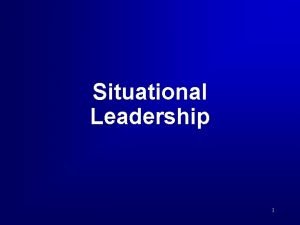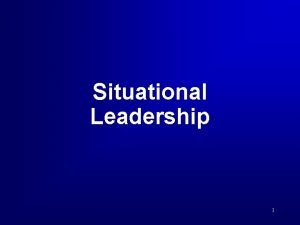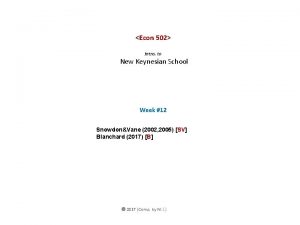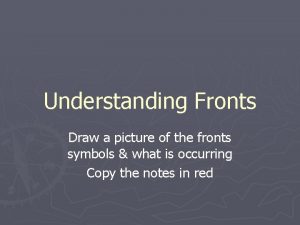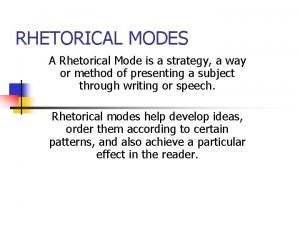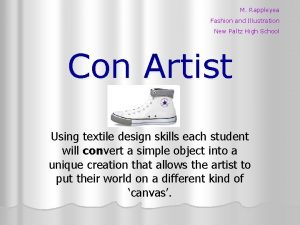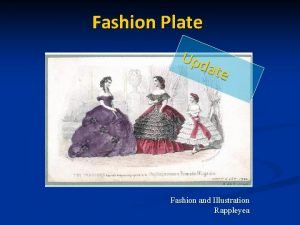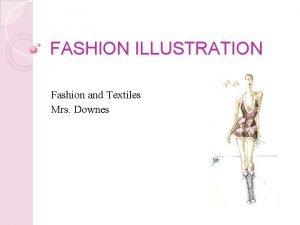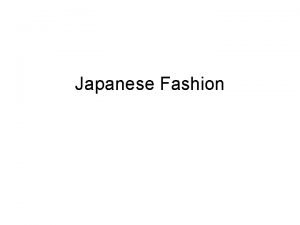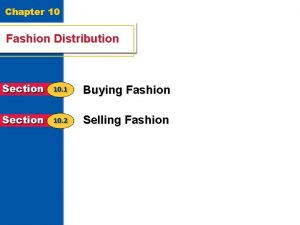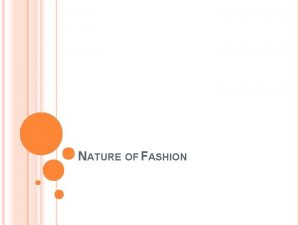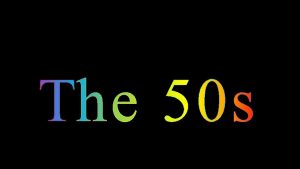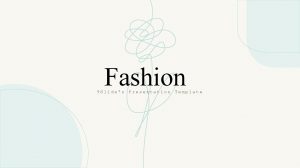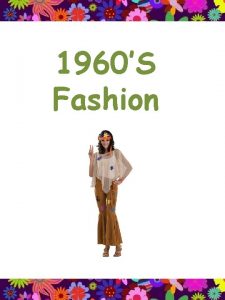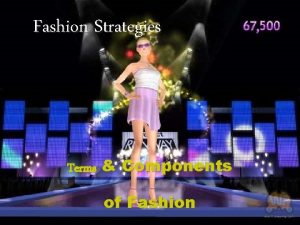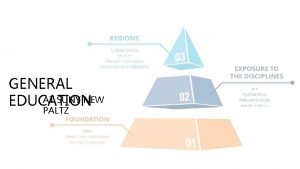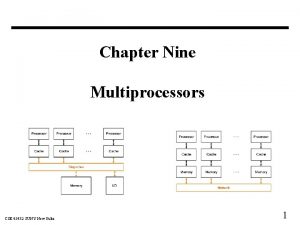M Rappleyea Fashion and Illustration New Paltz High























- Slides: 23

M. Rappleyea Fashion and Illustration New Paltz High School Con Artist Using textile design skills each student will convert a simple object into a unique creation that allows the artist to put their world on a different kind of ‘canvas’.

The Chuck Taylor All Star isn't simply a basketball sneaker or a nostalgic fashion statement; it's also a blank canvas, a clean slate that can serve as a medium for artistic expression.

Your Textile Design Here …or here

A textile http: //ifitshipitshere. blogspot. com/2009/04/pattern-pretty-minakanis-textile. html formed by weaving, knitting, crocheting, knotting, or pressing fibers together (felt). A textile is a flexible material consisting of a network of natural or artificial fibers often referred to as thread or yarn. Yarn is produced by spinning raw wool fibers, linen, cotton, or other material on a spinning wheel to produce long strands. The words fabric and cloth are used in textile assembly trades (such as tailoring and dressmaking) as synonyms for textile. However, there are subtle differences in these terms in specialized usage. is • Textile refers to any material made of interlacing fibers. • Fabric refers to any material made through weaving, knitting, crocheting, or bonding. • Cloth refers to a finished piece of fabric that can be used for a purpose such as covering a bed.

Textile design is the process of creating designs for fabrics. What is Textile Design ? Textile design is not the same as textile production, although textile designers would benefit from working with various fabrics and materials. Textile designers create designs on textiles and they use fabrics, cloth, and upholstery to fashion a wide range of products. Textiles are the basis of linens, bathing products, fashion, interior design, and furniture. And, textiles have grown up to branch out into installation art.

Textile Design Sample Robe: Kesi (slit tapestry), c. 1900, L 138 cm W 200 cm; possibly made for the Empress Dowager. The Empress Dowager preferred pastel shades of lavender and turquoise with designs of spider chrysanthemums interspersed with longevity characters. L 138 cm W 200 cm.

Wall Hanging Vientiane, Laos, 1994 Discontinuous and supplementary weft patterning, interlocking tapestry, silk. This richly patterned handing is intricately worked with geometric designs and was inspired by a traditional Lao skirt. Fashion Institute of Technology Textiles were used in ancient China in many more ways than nowadays. At home, they were draped on chairs and around beds for warmth and comfort, placed on and around tables and hung on walls for decoration. They were used for book covers and for framing paintings. They were fashioned into purses and cases to hold small articles to be carried on the person. In temples and monasteries, they were used as sutra covers, banners, canopies and hangings for worship and commemoration. As garments, the use of silk itself was an indication of status because the common people could only wear cotton, hemp and other fibres. Silk, raw or woven, represented wealth, for it was used as currency and for tax payment.

IN ALL PATTERNS there are four basic symmetry operations that may be performed upon a fundamental design or motif. translation rigid motion with repetition along a line reflection rigid motion with repetition across a line (axis) glide reflection rigid motion with reflected repetition along a line rotation rigid motion with repetition around a point WHAT IS A PATTERN? A pattern, whether in nature or art, relies upon three characteristics: a unit, repetition, and a system of organization. WHAT IS SYMMETRY? Symmetry is a fundamental organizing principle in nature and in culture. The analysis of symmetry allows for understanding the organization of a pattern.

translations reflections + reflections glide reflections + glide reflections rotations (2) reflections + rotations (2) + glide reflections rotations (2) + reflections rotations (4) + rotations (4) reflections + rotations (4)

THE BEAUTY OF ORIENTAL CARPETS can be approached not only in terms of art and mathematics, but also within the contexts of Islamic art and spirituality. Historically, throughout the Islamic world from Spain to Indonesia, patterns appear in architecture and interiors to organize space and to beautify the built environment. All patterns reflect the pure beauty of numbers, considered to be of divine origin in Islamic doctrine. And by their very nature, patterns exhibit multiplicity as expressions of unity, which is an attribute of God. Patterns in Oriental carpets may thus be seen as expressive of a world view in which multiplicity exists in relation to the unity of all existence.

In nature, symmetry is imperfect, although mathematicians may treat it as an ideal. In art, too, it seems that the approximation of symmetry, rather than its precision, teases the mind as it pleases the eye.

What is your world view? What are your favorite things? l What motifs interest you? l Pop Culture, Ancient culture, Political Culture …. l

batik Funky Geometric Harlequin Damask Animal prints Lips Fruit Floral

Mexican Japanese African Celtic

Argyle Paisley Gingham Polynesian Plaid Horses Marbled Graphic Text Primitive Spirals Ocean

Culture Jamming refection on life is a prerequisite for living, and the cultural, political and commercial symbols of our times are well worth rethinking on a regular basis… as seen in Wonderfully creative urban street art.


Brainstorming Laughing is to be encouraged. Criticism is not. l l l l Mainstream Shopping & Droplifting (Commercial and Anti-commercial) Rural Urban Offbeat Music Inspired Academic Psychedelic Culture, Culture Graffiti Art Green Geek Architecture Nature NO Wrong Answer

It can be any sneaker…


10 Steps for Boosting Creativity by Jeffrey Baumgartner 1. Listen to music by Johann Sebastian Bach. If Bach doesn't make you more creative, you should probably see your doctor - or your brain surgeon if you are also troubled by headaches, hallucinations or strange urges in the middle of the night. 2. Brainstorm. If properly carried out, brainstorming can help you not only come up with sacks full of new ideas, but can help you decide which is best. 3. Always carry a small notebook and a pen or pencil around with you. That way, if you are struck by an idea, you can quickly note it down. Upon rereading your notes, you may discover about 90% of your ideas are daft. Don't worry, that's normal. What's important are the 10% that are brilliant. 4. If you're stuck for an idea, open a dictionary, randomly select a word and then try to formulate ideas incorporating this word. You'd be surprised how well this works. The concept is based on a simple but little known truth: freedom inhibits creativity. There are nothing like restrictions to get you thinking. 5. Define your problem. Grab a sheet of paper, electronic notebook, computer or whatever you use to make notes, and define your problem in detail. You'll probably find ideas positively spewing out once you've done this. 6. If you can't think, go for a walk. A change of atmosphere is good for you and gentle exercise helps shake up the brain cells. 7. Don't watch TV. Experiments performed by the JPB Creative Laboratory show that watching TV causes your brain to slowly trickle out your ears and/or nose. It's not pretty, but it happens. 8. Don't do drugs. People on drugs think they are creative. To everyone else, they seem like people on drugs. 9. Read as much as you can about everything possible. Books exercise your brain, provide inspiration and fill you with information that allows you to make creative connections easily. 10. Exercise your brain. Brains, like bodies, need exercise to keep fit. If you don't exercise your brain, it will get flabby and useless. Exercise your brain by reading a lot (see above), talking to clever people and disagreeing with people - arguing can be a terrific way to give your brain cells a workout. But note, arguing about politics or film directors is good for you; bickering over who should clean the dishes is not.

Creative Challenge Create a mood board for inspiration with images, colors, shapes, themes. l Create a textile design through activity and research. l Create a unique sneaker illustration or construct an original article through the process of textile design l Other articles of clothing can be considered: l a baseball hat, hoodie or other commonplace ‘blank slate’ article. l Materials and designs can go beyond canvas and ordinary ‘textiles’.

In your sketchbook: l Collect Pictures of different types of textiles l Render the textiles for future reference l Make sketches for your textile design l Begin using your sketchbook regularly as a place to explore ideas, collect and scrapbook images, create fabulous illustrations…
 2007 middle school fashion
2007 middle school fashion Rees and ecker method procedure drawing
Rees and ecker method procedure drawing 3 basic components of media and information literacy
3 basic components of media and information literacy Individual tax computation format
Individual tax computation format Water pollution and unequal distribution illustration
Water pollution and unequal distribution illustration Very descriptive
Very descriptive Ritual or expressive model of communication
Ritual or expressive model of communication Isenheim altarpiece ap art history
Isenheim altarpiece ap art history Illustration of the steps in restriction digestion and pcr
Illustration of the steps in restriction digestion and pcr Directive supportive leadership
Directive supportive leadership High directive and low supportive behavior
High directive and low supportive behavior New york pennsylvania new jersey delaware
New york pennsylvania new jersey delaware New oil and new wineskin
New oil and new wineskin Strengths and weaknesses of the articles of confederation
Strengths and weaknesses of the articles of confederation New consumer capabilities
New consumer capabilities New classical macroeconomics
New classical macroeconomics Chapter 16 toward a new heaven and a new earth
Chapter 16 toward a new heaven and a new earth Leanne keene french ambassador arrives from paris
Leanne keene french ambassador arrives from paris New classical and new keynesian macroeconomics
New classical and new keynesian macroeconomics Picture of a warm front
Picture of a warm front P.i.e. writing method
P.i.e. writing method Jesus bridge illustration
Jesus bridge illustration Bridge illustration of salvation
Bridge illustration of salvation What is a rhetorical mode
What is a rhetorical mode









